Ec2 Press Any Key to Continue
Background
We recently had a problem with one of our AWS EC2 Instances after shutting it down, making some configuration changes and starting it back up. We were unable to SSH onto the machines despite the fact that the machine came up OK (we would keep getting a Connection Refused error). We reviewed the Security Group settings, Network Settings, reverted our configuration changes, made sure we were pointing to the correct IP address and much more, but we still couldn't SSH onto the machine.
Upon viewing the system logs, we noticed that one of the disk volumes failed to be mounted onto the machine. It was an Instance Store drive that apparently was remounted onto the machine after restarting it under a different device name. This prevented the boot up from completing, which as a result prevented the sshd daemon from being started up to allow us to SSH onto the machine. With us not being able to SSH onto the machine to effect repairs we were left dead in the water. But we eventually figured a way to allow us to view the file system and make the necessary changes to fix the issue, which is described in this blog post.
In our case it was an issue with the /etc/fstab that caused us to have to follow these steps, but there are other cases where these steps can also benefit you. For example, if you mistakingly configured sshd not to start on startup of the machine or if something else failed to run during boot up which prevented the sshd daemon from starting up.
High Level Process
To resolve this, we're going to basically unmount the bad machines root file system, mount it to a healthy machine so we can explore the file system and fix the issue, and then remount it back to the original instance.
Step by Step Process
Setup
Suppose we have our EC2 instance (call it prod-instance) which has booted up ok, but we're unable to SSH onto.
Steps
- Loin to the AWS Web Console
- Stop the prod-instance instance
- Detach the root EBS volume from theprod-instance
- Select theprod-instanceEC2 instance in the AWS console and view the content in the "Description" tab in the window bellow the instance list
- Search for the "Root device" field
- Click on the link next to it
- It should look something like this:/dev/xvda
- A dialog box will pop up
- Take a note of the EBS ID
- For the bellow the steps bellow, assume the EBS ID is vol-0c7bf2325c6ab485b
- Click on the EBS ID link
- This will take you to a new list with information on that EBS Volume
- This will take you to a new list with information on that EBS Volume
- Make sure the EBS Volumevol-0c7bf2325c6ab485b is selected and click Actions -> Detach Volume
- If you would like to abort this and reattach the volume, Jump to step #15
- Create a brand new micro instance that you're able to SSH into and let it startup. We'll call it maintenance-instance.
- Make sure that its in the same Region and Availability Zone of the machine you detached the root volume from. Volumes cannot switch between availability zones.
- Note: Be sure you can SSH onto the machine before proceeding forward
ssh -i {pem_file} {username}@{ec2_host_or_ip}
- Mount the prod-instance's old root EBS volume to themaintenance-instance as an additional drive
- Click on the "Volumes" link on the left side of the AWS EC2 Web Console under ELASTIC BLOCK STORE
- Search for the EBS Volume you detached (vol-0c7bf2325c6ab485b). It will also be listed as having the State "available" (as opposed to "in-use").
- Select the volume and clickActions -> Attach Volume
- This will open a modal
- Search for your themaintenance-instance and click on the entry
- By clicking on the entry it will put in a default value into the Device field. If it doesn't, you can put in the value /dev/sdf.
- Click Attach
- Note: You do not need to stop or restartmaintenance-instance before or after attaching the instance.
- SSH onto themaintenance-instance
- Login as root
sudo su
- Check the disk to ensure that theprod-instance's old root EBS volume is available and get the device name
- Run the following command to get information about what volumes are currently mounted (which should only be the default root volume at this point)
df -h
- This will produce a result like this:
Filesystem Size Used Avail Use% Mounted on devtmpfs 488M 64K 488M 1% /dev tmpfs 498M 0 498M 0% /dev/shm /dev/xvda1 7.8G 981M 6.7G 13% /
- What this tells you is that there is one main drive called /dev/xvda1 which is the root volume of themaintenance-instance. Thus we can ignore this device name.
- This will produce a result like this:
- Run the following command to find out what the device name is of the volume we want to effect repairs on
lsblk
- This will produce a result like this:
NAME MAJ:MIN RM SIZE RO TYPE MOUNTPOINT xvda 202:0 0 8G 0 disk └─xvda1 202:1 0 8G 0 part / xvdf 202:80 0 8G 0 disk └─xvdf1 202:81 0 8G 0 part
- What this tells you, is that there are 2 main disks attached, each with one partition. We've already found out that the xvda device is the original root volume of themaintenance-instance, so by process of elimination xvdf is the disk we mounted onto the machine and want to effect repairs on.
- This will produce a result like this:
- Get the device name of the volume you mounted onto the machine
- In our case, based off the output above, the device name is: /dev/xvdf1 (which is the partition of that disk)
- Note: you may have noticed the device name also available in the AWS console under the Description of the machine and under the Block devices section. However, the value provided in the AWS console isn't always the same as the one you will see when using the fdisk or lsblk command, so therefore you shouldn't use this value. Use the one provided in the fdisk or lsblk command.
- Run the following command to get information about what volumes are currently mounted (which should only be the default root volume at this point)
- Create the directory that you want to mount the volume to (this can be named and placed wherever you would like)
mkdir /badvolume
- Mount the drives partition to the directory
mount /dev/xvdf1 /badvolume
- Explore the file system and make the necessary change you would like to it
- Change directory to the newly mounted file system
cd /badvolume
- Note: In our case, since we were dealing with a mounting issue, we had to modify the /etc/fstab file to prevent the machine from trying to mount the volume that was failing. Since theprod-instance's root volume was mounted onto the /badvolume directory, the fstab file that we need to fix is at /badvolume/etc/fstab.
- We simply commented out the bad entry and then moved on
- When you have completed your repairs, move onto the next step
- Change directory to the newly mounted file system
- Unmount the drive from the machine
umount /badvolume
- Switch back to the AWS Web Console
- Detach thevol-0c7bf2325c6ab485b volume from themaintenance-instance
- Click on the "Volumes" link on the left side of the AWS Web Console under ELASTIC BLOCK STORE
- Search for the EBS Volume you detached (vol-0c7bf2325c6ab485b). It will also be listed as having the State "in-use".
- Select the volume and clickActions -> Detach Volume
- Re-Attach thevol-0c7bf2325c6ab485b volume to theprod-instance as the root volume
- Click on the "Volumes" link on the left side of the AWS Web Console under ELASTIC BLOCK STORE
- Search for the EBS Volume you detached (vol-0c7bf2325c6ab485b). It will also be listed as having the State "available".
- Select the volume and clickActions -> Attach Volume
- This will open a modal
- Search for your theprod-instance
- Set the Device as the root volume with the value:/dev/xvda
- Click Attach
- Restart theprod-instance
- Test SSH'ing onto theprod-instance
- If you're still having issues connecting to theprod-instance then check the system logs of the machine to debug the problem and, if necessary, repeat these steps to fix the issue with the drive.
- When you're all done you can terminate themaintenance-instance
steinhauerhimusince37.blogspot.com
Source: http://site.clairvoyantsoft.com/fixing-an-aws-ec2-instance-boot-up-issue/

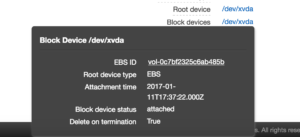

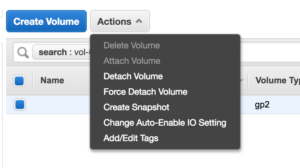


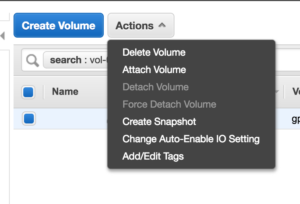
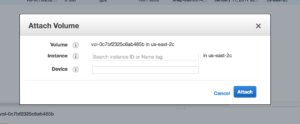
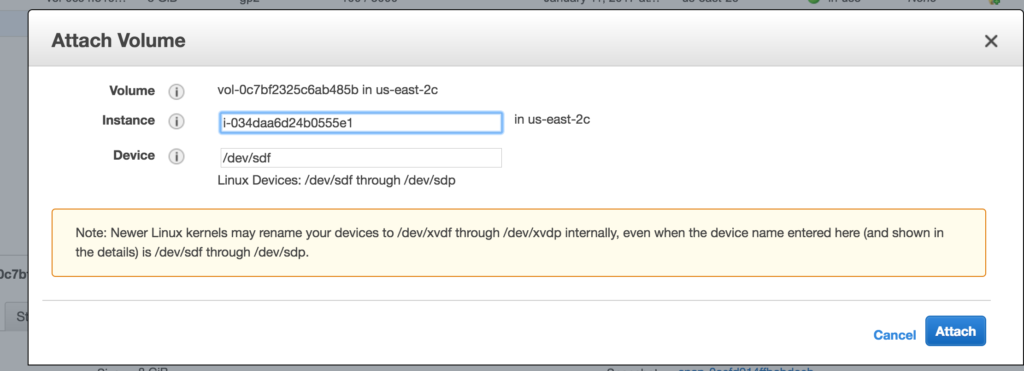
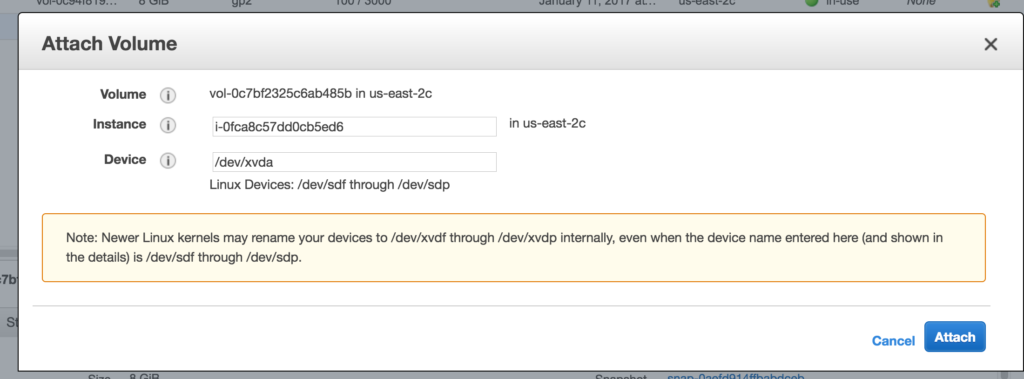
Post a Comment for "Ec2 Press Any Key to Continue"